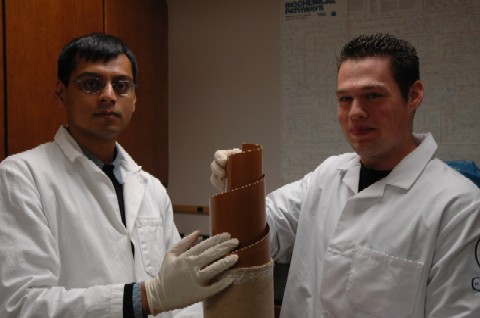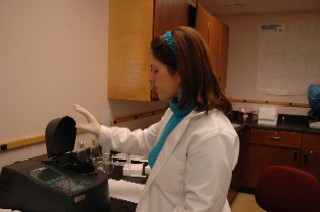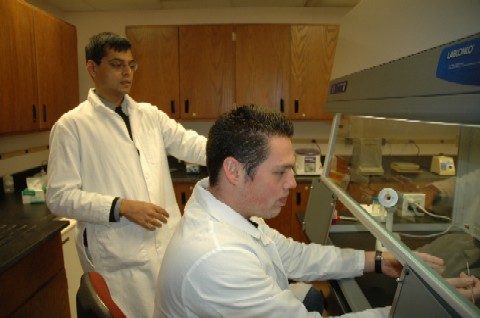Navigation
You Still Can't Drink the Water, But Now You Can Touch It
Engineers have developed a system that uses a simple water purification technique that can eliminate 100 percent of the microbes in New Orleans water samples left from Hurricane Katrina. The technique makes use of specialized resins, copper and hydrogen peroxide to purify tainted water.
Engineers have developed a system that uses a simple water purification technique that can eliminate 100 percent of the microbes in New Orleans water samples left from Hurricane Katrina. The technique makes use of specialized resins, copper and hydrogen peroxide to purify tainted water.
 |
| Vishal Shah (on left) with undergraduate student Daniel Badia, both of Dowling College, hold the polymer that is critical to the water filtration system they are helping to develop. Photo by Kelly Kazemier, Dowling College |
The system--safer, cheaper and simpler to use than many other methods--breaks down a range of toxic chemicals. While the method cleans the water, it doesn't yet make the water drinkable. However, the method may eventually prove critical for limiting the spread of disease at disaster sites around the world.
National Science Foundation-funded researchers Vishal Shah and Shreya Shah of Dowling College in Long Island, New York, collaborated with Boris Dzikovski of Cornell University and Jose Pinto of New York's Polytechnic University in Brooklyn to develop the technique. They will publish their findings in Environmental Pollution.
"After the disaster of Hurricane Katrina, scientists have had their backs against the wall trying to develop safeguards," said Shah. "No one knows when a similar situation may arise. We need to develop a treatment for decontaminating flood water before it either comes in contact with humans or is pumped into natural reservoirs."
 |
| Dowling College Undergraduate student Ms. Mia Jurjevic working in the laboratory carrying out spectrophotometric analysis.. Photo by Kelly Kazemier |
The treatment system that the researchers are developing is simple: a polymer sheet of resins containing copper is immersed in the contaminated flood water. The addition of hydrogen peroxide generates free radicals on the polymer. The free radicals remain bound to the sheet, where they come in contact with bacteria and kill them.
The researchers are working to lower the amount of copper in the treated water end product and improving the system's impact on chemical toxins. Shah believes it could be ready for emergency use within five to seven years.
To develop their process, the researchers built upon a century-old chemical mechanism called the Fenton reaction - a process wherein metal catalysts cause hydrogen peroxide to produce large numbers of free radicals.
Free radicals are atoms or molecules that have an extra electron in dire need of a partner (they obtain the partner by stripping it from a nearby atom, damaging the "victim" in the process). In large quantities, the radicals can destroy toxic chemicals and even bombard bacteria to death or irreparably damage a microorganism's cell membrane.
 |
| Dr. Shah (Assistant Professor of Biology) training Undergraduate student Mr. Daniel Badia (on right) teaching microbiological techniques. Photo by: Kelly Kazemier |
Applying their technique to water from the Industrial and 17th Street canals in New Orleans, the researchers were able to destroy all of the bacteria within 15 minutes. In tests with laboratory water samples containing even higher bacterial concentrations, the exact same process killed at least 99 percent of the bacteria in 90 minutes.
January 9, 2007: The National Science Foundation is responsible for the contents of this press release.
Additional information:
Principal Investigators
Vishal Shah, Dowling College (631) 244-3339 ShahV@dowling.edu
Search
Latest articles
Agriculture
- World Water Week: Healthy ecosystems essential to human health: from coronavirus to malnutrition Online session Wednesday 24 August 17:00-18:20
- World Water Week: Healthy ecosystems essential to human health: from coronavirus to malnutrition Online session Wednesday 24 August 17:00-18:20
Air Pollution
- "Water and Sanitation-Related Diseases and the Changing Environment: Challenges, Interventions, and Preventive Measures" Volume 2 Is Now Available
- Global Innovation Exchange Co-Created by Horizon International, USAID, Bill and Melinda Gates Foundation and Others
Biodiversity
- It is time for international mobilization against climate change
- World Water Week: Healthy ecosystems essential to human health: from coronavirus to malnutrition Online session Wednesday 24 August 17:00-18:20
Desertification
- World Water Week: Healthy ecosystems essential to human health: from coronavirus to malnutrition Online session Wednesday 24 August 17:00-18:20
- UN Food Systems Summit Receives Over 1,200 Ideas to Help Meet Sustainable Development Goals
Endangered Species
- Mangrove Action Project Collaborates to Restore and Preserve Mangrove Ecosystems
- Coral Research in Palau offers a “Glimmer of Hope”
Energy
- Global Innovation Exchange Co-Created by Horizon International, USAID, Bill and Melinda Gates Foundation and Others
- Wildlife Preservation in Southeast Nova Scotia
Exhibits
- Global Innovation Exchange Co-Created by Horizon International, USAID, Bill and Melinda Gates Foundation and Others
- Coral Reefs
Forests
- NASA Satellites Reveal Major Shifts in Global Freshwater Updated June 2020
- Global Innovation Exchange Co-Created by Horizon International, USAID, Bill and Melinda Gates Foundation and Others
Global Climate Change
- It is time for international mobilization against climate change
- It is time for international mobilization against climate change
Global Health
- World Water Week: Healthy ecosystems essential to human health: from coronavirus to malnutrition Online session Wednesday 24 August 17:00-18:20
- More than 400 schoolgirls, family and teachers rescued from Afghanistan by small coalition
Industry
- "Water and Sanitation-Related Diseases and the Changing Environment: Challenges, Interventions, and Preventive Measures" Volume 2 Is Now Available
- Global Innovation Exchange Co-Created by Horizon International, USAID, Bill and Melinda Gates Foundation and Others
Natural Disaster Relief
- STOP ATTACKS ON HEALTH CARE IN UKRAINE
- Global Innovation Exchange Co-Created by Horizon International, USAID, Bill and Melinda Gates Foundation and Others
News and Special Reports
- World Water Week: Healthy ecosystems essential to human health: from coronavirus to malnutrition Online session Wednesday 24 August 17:00-18:20
- STOP ATTACKS ON HEALTH CARE IN UKRAINE
Oceans, Coral Reefs
- World Water Week: Healthy ecosystems essential to human health: from coronavirus to malnutrition Online session Wednesday 24 August 17:00-18:20
- Mangrove Action Project Collaborates to Restore and Preserve Mangrove Ecosystems
Pollution
- Zakaria Ouedraogo of Burkina Faso Produces Film “Nzoue Fiyen: Water Not Drinkable”
- "Water and Sanitation-Related Diseases and the Changing Environment: Challenges, Interventions, and Preventive Measures" Volume 2 Is Now Available
Population
- "Water and Sanitation-Related Diseases and the Changing Environment: Challenges, Interventions, and Preventive Measures" Volume 2 Is Now Available
- "Water and Sanitation-Related Diseases and the Changing Environment: Challenges, Interventions, and Preventive Measures" Volume 2 Is Now Available
Public Health
- Honouring the visionary behind India’s sanitation revolution
- Honouring the visionary behind India’s sanitation revolution
Rivers
- World Water Week: Healthy ecosystems essential to human health: from coronavirus to malnutrition Online session Wednesday 24 August 17:00-18:20
- Mangrove Action Project Collaborates to Restore and Preserve Mangrove Ecosystems
Sanitation
- Honouring the visionary behind India’s sanitation revolution
- Honouring the visionary behind India’s sanitation revolution
Toxic Chemicals
- "Water and Sanitation-Related Diseases and the Changing Environment: Challenges, Interventions, and Preventive Measures" Volume 2 Is Now Available
- Actions to Prevent Polluted Drinking Water in the United States
Transportation
- "Water and Sanitation-Related Diseases and the Changing Environment: Challenges, Interventions, and Preventive Measures" Volume 2 Is Now Available
- Urbanization Provides Opportunities for Transition to a Green Economy, Says New Report
Waste Management
- Honouring the visionary behind India’s sanitation revolution
- Honouring the visionary behind India’s sanitation revolution
Water
- Honouring the visionary behind India’s sanitation revolution
- Honouring the visionary behind India’s sanitation revolution
Water and Sanitation
- Honouring the visionary behind India’s sanitation revolution
- Honouring the visionary behind India’s sanitation revolution

